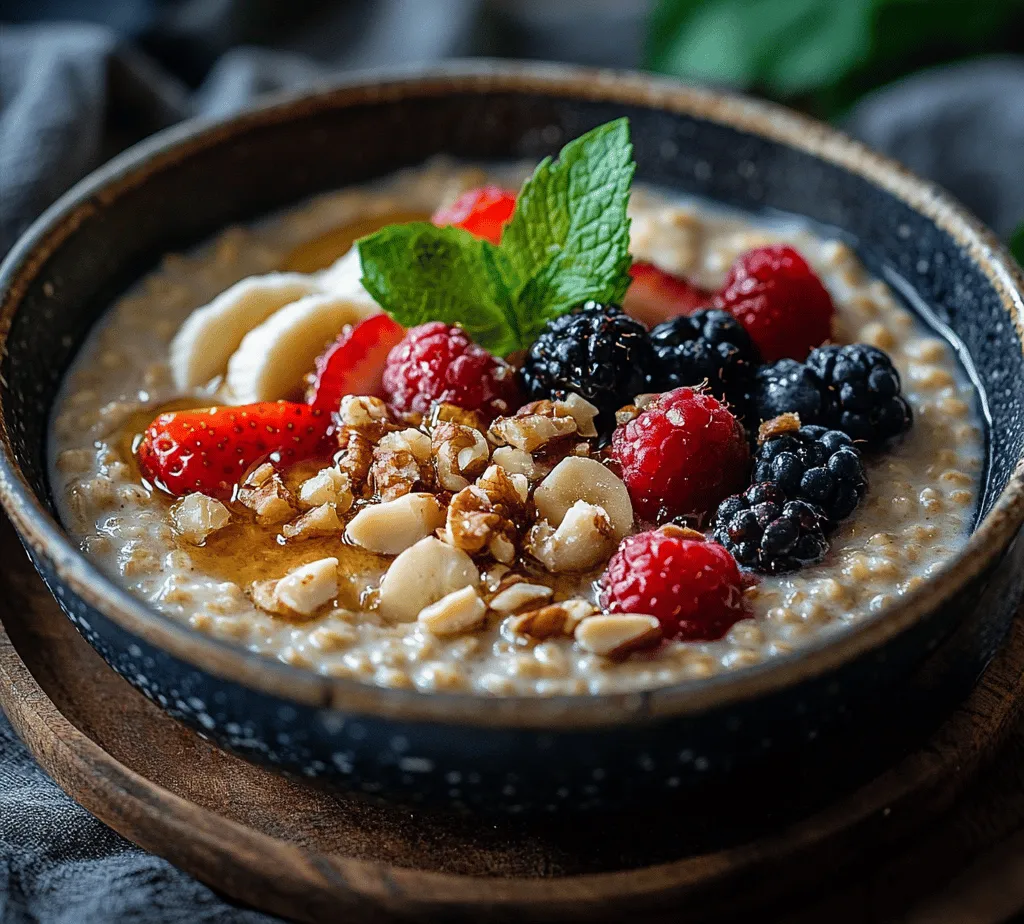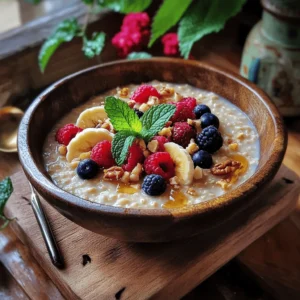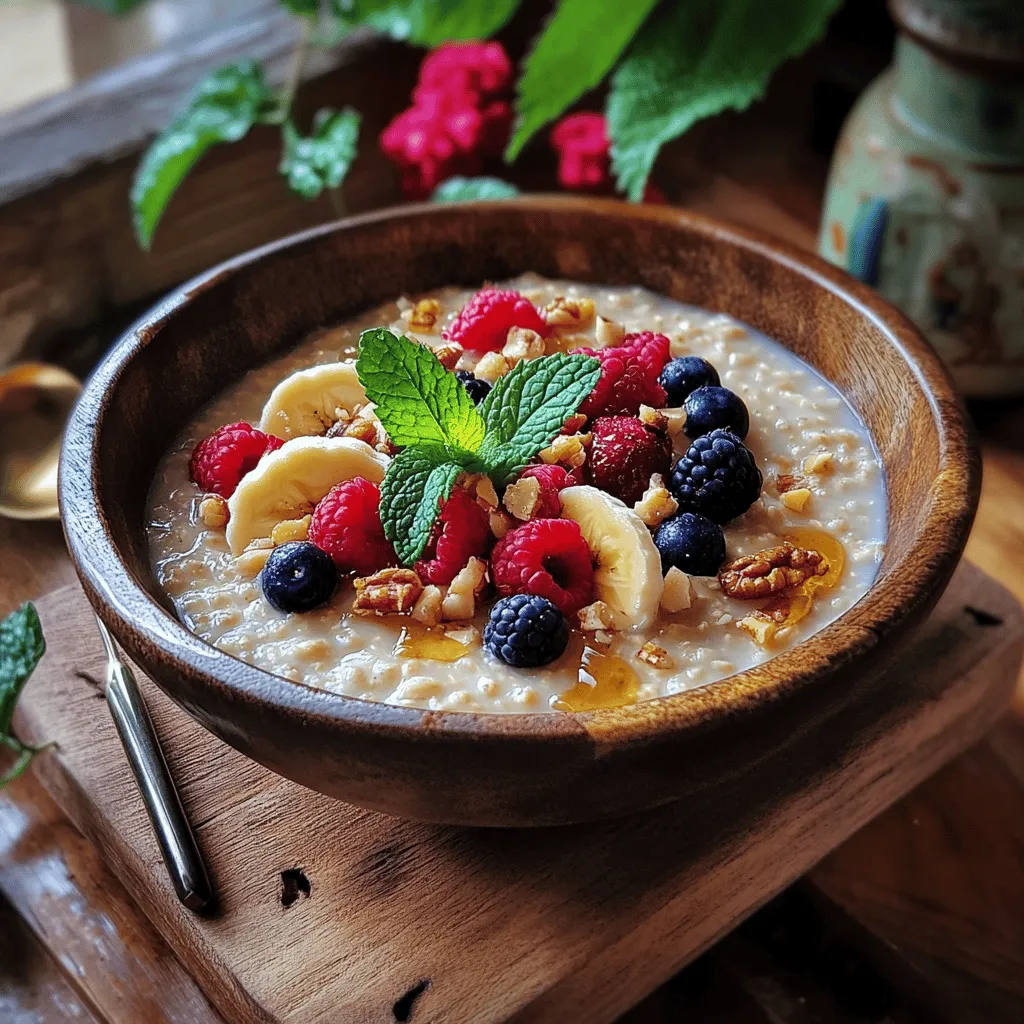In recent years, barley has emerged as a star player in the world of healthy grains, capturing the attention of health-conscious eaters and food enthusiasts alike. This ancient grain, once primarily associated with animal feed and beer production, has made a significant comeback, celebrated for its impressive nutritional profile and versatility in a variety of dishes. Among the many culinary applications of barley, Creamy Barley Porridge stands out as a wonderfully nourishing breakfast option that combines comfort and health in every spoonful.
Creamy Barley Porridge is not just another bowl of cereal; it’s a rich, satisfying meal that provides sustained energy to kickstart your day. This dish can be easily customized to accommodate various dietary preferences, making it a favorite among vegans, vegetarians, and anyone looking to eat a little healthier. The creamy texture, achieved through cooking barley with milk or plant-based alternatives, is paired with a medley of flavors that can be adjusted to suit your taste buds. Whether you prefer a sweet breakfast topped with fruits and nuts or a savory version enhanced by herbs and spices, this porridge is a canvas for your culinary creativity.
Understanding Barley
Before diving into the specifics of making Creamy Barley Porridge, it’s essential to appreciate the grain at the heart of the dish: barley. This wholesome grain is packed with nutrients, making it an excellent choice for those looking to improve their diet.
Nutritional Profile of Pearled Barley
Pearled barley, which is the form most commonly used in porridge, is a whole grain that has had its outer hull removed and polished to enhance its appearance. This process removes some of the bran and germ, which means it’s not as high in fiber as hulled barley. However, pearled barley still offers a robust nutritional profile. It is rich in fiber, protein, vitamins, and minerals, providing about 193 calories, 6 grams of protein, and 3.6 grams of dietary fiber per cooked cup. Additionally, it contains important nutrients such as B vitamins, iron, magnesium, and selenium.
Health Benefits of Incorporating Barley into Your Diet
Incorporating barley into your diet can yield a variety of health benefits. Its high fiber content is beneficial for digestive health, helping to promote regularity and prevent constipation. The soluble fiber found in barley can also help lower cholesterol levels, reducing the risk of heart disease. Moreover, barley has a low glycemic index, meaning it releases glucose into the bloodstream slowly, making it an excellent choice for maintaining stable blood sugar levels. These attributes make barley an ideal grain for those managing diabetes or looking to maintain steady energy levels throughout the day.
Differences Between Pearled and Hulled Barley: Which to Choose?
When selecting barley for your porridge, you may come across two primary forms: pearled barley and hulled barley. Pearled barley, as mentioned, has been processed to remove the outer hull and some bran, resulting in a faster cooking time and a smoother texture. On the other hand, hulled barley is less processed and retains more of its bran and germ, making it higher in fiber and nutrients. While hulled barley is certainly a healthier option, it requires a longer cooking time and may not provide the creamy texture that is characteristic of porridge. For this recipe, pearled barley is recommended for its balance of convenience and taste.
Key Ingredients for Creamy Barley Porridge
To create a truly delicious and creamy barley porridge, you will need a selection of key ingredients. Each plays a specific role in enhancing the flavor and texture of the dish.
Pearled Barley: The Base Ingredient
As the star of the show, pearled barley serves as the foundation of this porridge recipe. It is not only nutritious but also provides a chewy texture that contrasts beautifully with the creamy elements of the dish. When cooked properly, it becomes tender but still holds its shape, offering a satisfying mouthfeel.
Water or Vegetable Broth: Flavor Enhancement
The cooking liquid is crucial for flavor development. While water is the most common choice, using vegetable broth can elevate the flavor profile of your porridge, adding depth and richness. This is particularly beneficial if you intend to make a savory version of the porridge, as the broth can infuse the dish with additional umami notes.
Salt: Importance in Balancing Flavors
A pinch of salt is essential in any recipe, including this creamy porridge. Salt enhances the natural flavors of the ingredients, ensuring that your porridge is well-seasoned and delicious. It can also help highlight the sweetness of any added fruits or sweeteners.
Milk (Dairy vs. Plant-Based): Creaminess and Dietary Considerations
For that signature creaminess, milk is a crucial ingredient. You have the option to use dairy milk or a variety of plant-based alternatives, such as almond milk, oat milk, or coconut milk. Each type of milk will impart its unique flavor and texture to the porridge. If you’re looking for a richer taste, consider using full-fat coconut milk or a blend of different plant milks. If you prefer a lighter option, unsweetened almond or oat milk works wonderfully.
Sweeteners (Honey vs. Maple Syrup): Natural Sweetness and Flavor Variations
The choice of sweetener can transform your porridge from savory to sweet. Honey and maple syrup are popular natural sweeteners that can be added to taste. Honey offers a floral sweetness, while maple syrup brings a warm, caramel-like flavor. For a healthier option, you might also consider using agave syrup or stevia, depending on your dietary preferences.
Vanilla Extract and Cinnamon: Aromatic Enhancements
To enhance the overall flavor of your porridge, adding a splash of vanilla extract and a sprinkle of cinnamon can work wonders. Vanilla adds a sweet, aromatic note that pairs beautifully with the creaminess of the milk, while cinnamon introduces warmth and depth, making each bite feel comforting and indulgent.
Nuts and Fruits: Nutritional Boosts and Texture Contrasts
To finish off your creamy barley porridge, consider topping it with a variety of nuts and fruits. Nuts not only add a satisfying crunch but also provide healthy fats and protein. Almonds, walnuts, or pecans are excellent choices. Fresh fruits, such as bananas, berries, or diced apples, can add natural sweetness and a refreshing contrast to the creamy base. Dried fruits, like raisins or cranberries, can also be used for added texture and flavor.
Optional Ingredients: Variations for Personal Taste
The beauty of Creamy Barley Porridge lies in its versatility. You can easily customize the recipe to suit your preferences or dietary needs. For a protein boost, consider stirring in some Greek yogurt or nut butter. If you’re feeling adventurous, try adding spices like nutmeg or cardamom for an extra layer of flavor. You can also experiment with different toppings, such as seeds, granola, or a drizzle of nut butter for added richness.
Step-by-Step Instructions for Perfecting Creamy Barley Porridge
Now that you have a clear understanding of the ingredients and their roles in the recipe, let’s dive into the step-by-step process for preparing Creamy Barley Porridge. This detailed guide will ensure that you achieve the perfect consistency and flavor every time.
Preparing the Barley
1. Rinse the Barley: Begin by measuring out the desired amount of pearled barley. Rinse it under cold water in a fine mesh strainer to remove any dust or debris. This step helps to ensure a clean flavor in your porridge.
2. Soak the Barley (Optional): While not necessary, soaking the barley for a few hours or overnight can reduce cooking time and help with digestibility. If you choose to soak, be sure to drain and rinse the barley again before cooking.
Cooking the Barley
3. Combine Ingredients in a Pot: In a medium-sized pot, combine the rinsed barley, water (or vegetable broth), and a pinch of salt. Use a ratio of 1 cup of barley to 3 cups of liquid for a creamy texture. Adjust the liquid depending on your desired consistency.
4. Bring to a Boil: Place the pot over medium-high heat and bring the mixture to a boil. Once boiling, reduce the heat to low and cover the pot with a lid.
5. Simmer the Barley: Allow the barley to simmer for about 30-40 minutes, stirring occasionally. This will help prevent sticking and ensure even cooking. The barley is done when it is tender yet still chewy, and the liquid has mostly absorbed. If you prefer a creamier porridge, you can add more liquid and cook for an additional 5-10 minutes.
Making it Creamy
6. Add Milk: Once the barley is cooked to your liking, stir in your choice of milk (dairy or plant-based) until the desired creaminess is achieved. Start with ½ cup and add more as needed. Return the pot to low heat and stir until heated through.
7. Incorporate Flavorings: At this stage, add the vanilla extract and cinnamon, adjusting the amounts to taste. Stir well to combine and allow the flavors to meld for a couple of minutes.
Serve and Enjoy
8. Top with Your Favorites: Remove the pot from heat and serve the porridge in bowls. Top with your favorite nuts, fruits, and sweeteners. Drizzle with honey or maple syrup for added sweetness, and enjoy your creamy barley porridge warm.
By following these detailed steps, you’ll create a delicious and nourishing Creamy Barley Porridge that can be enjoyed as a satisfying breakfast or even a comforting snack throughout the day. Whether you stick to the classic recipe or explore variations, this dish is sure to become a staple in your kitchen.

Rinsing Barley: Importance of Removing Excess Starch
Rinsing your barley before cooking is a crucial step that should not be overlooked. Barley grains often come coated with excess starch, which can result in a gummy or gluey texture when cooked. By rinsing the barley under cold running water, you help remove this excess starch, leading to a fluffier, creamier porridge that has a pleasing mouthfeel. Simply place the barley in a fine-mesh strainer and rinse it for a minute or two until the water runs clear. This simple process sets the stage for the perfect creamy barley porridge that you and your family will love.
Cooking the Barley: Tips for Achieving the Perfect Texture
Once your barley is rinsed, it’s time to cook it to perfection. For a creamy porridge, you’ll want to use a 1:4 ratio of barley to liquid, which can be water, milk, or a combination of both. Here’s how to achieve the best texture:
1. Bring to a Boil: In a medium saucepan, combine the rinsed barley and four cups of your chosen liquid. Bring it to a rolling boil over medium-high heat.
2. Reduce Heat and Simmer: Once boiling, reduce the heat to low and cover the saucepan. Allow the barley to simmer gently for about 30-40 minutes. It’s essential to stir occasionally to prevent sticking and ensure even cooking.
3. Check for Doneness: The barley is ready when it is tender but still has a slight bite to it. You want to avoid overcooking it, leading to a mushy texture. If you find that the liquid has reduced too much before the barley is cooked, simply add a little more water or milk.
4. Finishing Touches: Once the barley has reached the desired consistency, remove it from heat. For an extra creamy texture, stir in a splash of milk or a dollop of your preferred cream before serving.
Mixing in Additional Ingredients: Timing for Optimal Creaminess
To achieve the ultimate creaminess in your barley porridge, timing is key when adding other ingredients. If you plan to incorporate sweeteners, spices, or flavor enhancers, consider adding them at specific points during the cooking process:
– Sweeteners: If you’re using maple syrup, honey, or brown sugar, add them in the last five minutes of cooking. This timing allows the sweeteners to meld into the porridge without losing their flavor.
– Spices: Ground cinnamon, nutmeg, or vanilla extract can be added during the last 10 minutes of cooking. This way, the spices have enough time to infuse their flavors into the porridge, creating a warm and comforting aroma.
– Fruit: Fresh fruits, such as berries or sliced bananas, can be stirred in just before serving to maintain their texture and freshness. On the other hand, dried fruits like raisins or cranberries can be added earlier in the cooking process to rehydrate and soften.
Serving Suggestions: Ideal Toppings and Garnishes
The beauty of creamy barley porridge lies in its versatility, allowing you to customize each bowl to your liking. Here are some ideal toppings and garnishes to elevate your porridge experience:
– Fresh Fruits: Top your porridge with seasonal fruits such as berries, sliced peaches, or bananas. The natural sweetness and tartness of fresh fruits complement the creamy texture of the barley beautifully.
– Nuts and Seeds: Add a handful of toasted almonds, walnuts, or pumpkin seeds for a satisfying crunch. These not only enhance the flavor but also provide an additional nutritional boost.
– Yogurt or Cream: A dollop of Greek yogurt or a splash of cream can enhance the creaminess and add a tangy contrast to the dish.
– Cinnamon and Nutmeg: A sprinkle of ground cinnamon or nutmeg adds warmth and depth to the flavor profile of your porridge.
Creative Variations on Creamy Barley Porridge
One of the fantastic aspects of creamy barley porridge is its adaptability. Here are several creative variations you can try to keep things exciting:
Seasonal Fruit Toppings: How to Adapt the Recipe with Fresh Produce
Incorporating seasonal fruits not only enhances the flavor but also adds a vibrant color to your porridge. In spring and summer, consider topping your porridge with ripe strawberries, blueberries, or sliced kiwi. In the fall, diced apples sautéed with cinnamon or pumpkin puree can create a cozy, autumn-inspired bowl.
Alternative Sweeteners: Exploring Different Taste Profiles
While traditional sweeteners like honey and maple syrup are popular, experimenting with alternatives can lead to delightful discoveries. Try using agave nectar for a lighter sweetness or coconut sugar for a caramel-like flavor. For those looking to reduce sugar intake, consider using ripe bananas or unsweetened applesauce to naturally sweeten your porridge.
Nut and Seed Variations: Enhancing Texture and Nutrition
Incorporating different nuts and seeds can transform the texture and nutritional value of your barley porridge. Chia seeds or flaxseeds can add a boost of omega-3 fatty acids, while a sprinkle of hemp seeds provides protein. You can also experiment with different nut butters—like almond or cashew butter—to create a rich, nutty flavor profile.
Dairy-Free and Vegan Adaptations: Making the Recipe Accessible for All Diets
For those following a dairy-free or vegan lifestyle, creamy barley porridge can easily be adapted. Simply replace cow’s milk with almond milk, coconut milk, or oat milk. These alternatives not only maintain the creaminess of the dish but also add unique flavors.
The Versatility of Barley Porridge
Creamy barley porridge is not just a breakfast option; its versatility allows it to be enjoyed at any meal of the day.
Serving Suggestions Beyond Breakfast: Lunch or Dinner Possibilities
Consider serving barley porridge as a savory dish for lunch or dinner. Top it with sautéed vegetables, a poached egg, or a sprinkle of cheese for a satisfying meal. Additionally, barley porridge can serve as a hearty base for grain bowls, topped with proteins and greens for a balanced dish.
Meal Prep Ideas: How to Store and Reheat Leftovers
If you’re making a big batch of barley porridge, you can easily store leftovers in an airtight container in the refrigerator for up to five days. When ready to enjoy, simply reheat on the stove or in the microwave, adding a splash of liquid to bring back the creamy texture.
Incorporating Barley Porridge into a Balanced Diet
Barley porridge is not just a delicious meal; it’s also a nutritious one. It’s high in fiber and protein, making it a great option for those looking to maintain a balanced diet. Incorporating barley porridge into your meals can help keep you feeling full and satisfied, which is crucial for weight management and overall health.
Nutritional Benefits of Creamy Barley Porridge
Barley porridge is not only satisfying but also packed with nutrients, making it an excellent choice for breakfast or any meal.
Detailed Breakdown of Calories and Nutrients per Serving
A standard serving of creamy barley porridge (approximately one cup) contains approximately 150-200 calories, depending on the liquid used and any added sweeteners or toppings. It provides around 6 grams of protein, 5 grams of fiber, and essential vitamins and minerals, including B vitamins, magnesium, and iron.
How Barley Contributes to Heart Health, Digestion, and Sustained Energy
Barley is a whole grain that is rich in soluble fiber, which has been shown to help lower cholesterol levels and promote heart health. Its high fiber content also aids digestion, keeping your gut healthy and functioning optimally. Additionally, barley has a low glycemic index, which means it releases energy slowly, helping to maintain steady blood sugar levels throughout the day.
The Role of Fiber in a Balanced Diet
Fiber plays a critical role in maintaining a balanced diet. It promotes feelings of fullness, supports digestive health, and can help reduce the risk of chronic diseases such as heart disease and diabetes. By incorporating creamy barley porridge into your meals, you’re ensuring that you’re getting a good dose of this essential nutrient.
Conclusion
Creamy barley porridge is a delicious and nutritious option that can easily be adapted to suit your tastes and dietary needs. With its rich texture and ability to pair well with a variety of toppings, it’s a dish that can be enjoyed at any time of the day.
Incorporating this wholesome recipe into your meals not only provides numerous health benefits but also encourages you to experiment with flavors and textures that reflect your personal preferences. So, gather your ingredients, unleash your creativity, and enjoy the comforting goodness of creamy barley porridge as a delightful addition to your daily meals.



